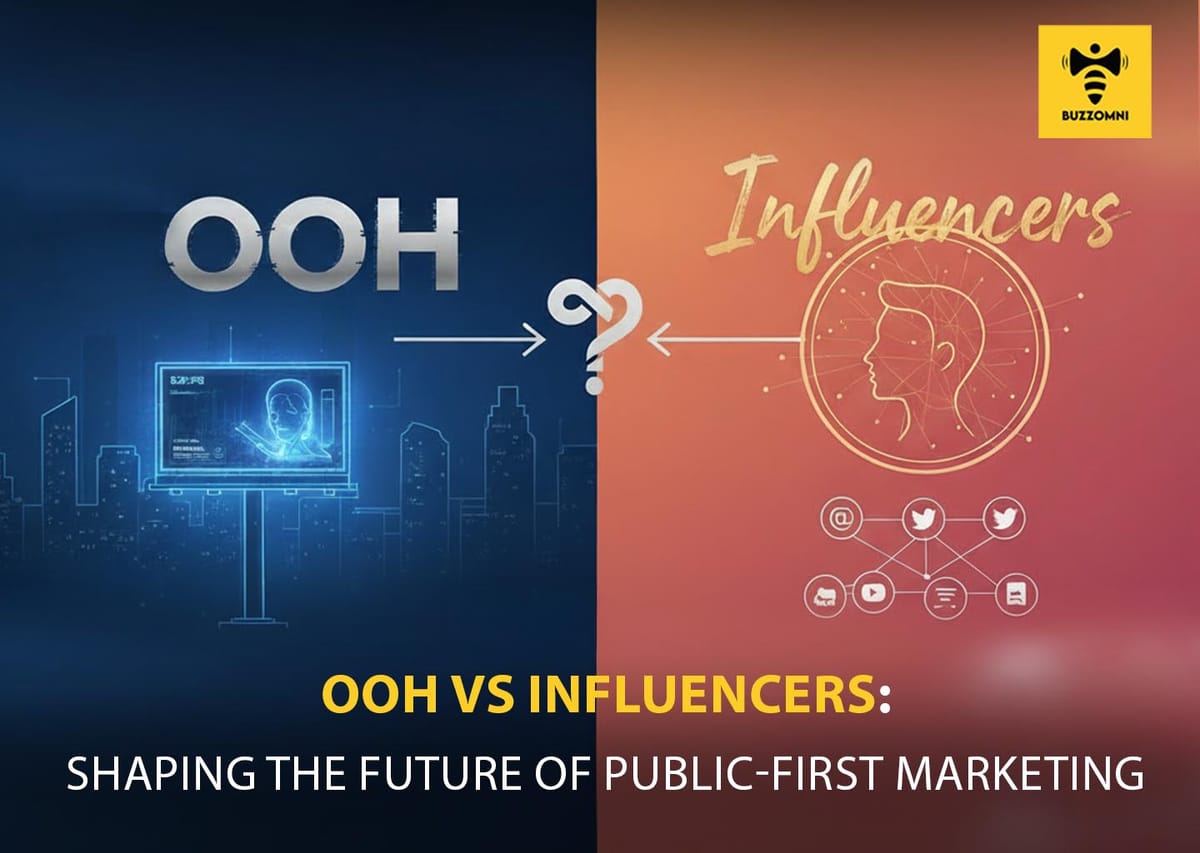Can OOH Replace Influencers? The New Age of Public-First Advertising
As marketing evolves, brands are exploring how Out-of-Home (OOH) advertising can rival influencer campaigns, offering a public-first approach that combines visibility, credibility, and real-world engagement.

Table of Contents
- Introduction
- The Limitations of Influencer Marketing
- Why OOH Is the Public-First Choice
- Bridging OOH and Influencer Strategies
- The Future of Public-First Advertising
- Conclusion
Introduction
In the dynamic world of marketing, brands have traditionally leaned on influencer marketing to create awareness, credibility, and engagement. Influencers, with their personal connection to audiences, have been a go-to strategy for social campaigns. However, with rising costs, decreasing authenticity, and growing consumer scepticism, marketers are exploring alternative ways to reach audiences effectively. This is where Out-of-Home (OOH) advertising, with companies like BuzzOmni leading the way, is stepping into the spotlight, offering a public-first approach that could rival—or even complement—influencer strategies.
The Limitations of Influencer Marketing
Influencer marketing has undeniable benefits. Influencers can drive engagement, provide relatable content, and even influence purchase decisions. Yet, the landscape is changing. Consumers are becoming more discerning, increasingly wary of paid promotions disguised as genuine recommendations. Moreover, influencer campaigns often come with hefty price tags, especially for top-tier personalities. Tracking measurable ROI can also be challenging, and brand messages risk getting lost in the crowded digital noise.
These limitations have opened the door for OOH advertising to showcase its unique strengths. Unlike influencer campaigns, OOH doesn’t rely on a single personality or fleeting digital attention. Instead, it leverages physical presence, visibility, and repetition to embed brand messages directly into the daily lives of consumers.
Why OOH Is the Public-First Choice
OOH advertising—ranging from billboards and transit ads to mall installations and street furniture—places brands directly in front of people in real-world environments. Unlike digital ads, which can be skipped or blocked, OOH captures attention passively but consistently. The public-first nature of OOH ensures that messages are seen by diverse audiences in relevant contexts, from commuters on busy roads to shoppers in bustling retail areas.
One of the key advantages of OOH over influencer marketing is credibility through presence. Seeing a brand prominently displayed in high-traffic areas can create subconscious trust and familiarity. This is amplified when OOH campaigns are strategically paired with digital extensions, such as QR codes, social media tie-ins, or augmented reality experiences, allowing brands to combine physical impact with measurable engagement.
Bridging OOH and Influencer Strategies
While OOH is emerging as a strong alternative, it doesn’t necessarily have to replace influencers entirely. Instead, brands can create hybrid campaigns that integrate both. For instance, influencers can amplify the visibility of an OOH campaign by sharing content or live experiences, while the OOH elements reinforce brand presence in the real world. This approach ensures maximum reach, repeated exposure, and multi-channel reinforcement, bridging the gap between digital credibility and physical visibility.
The Future of Public-First Advertising
With urban landscapes evolving into more interactive and tech-enabled environments, OOH advertising is no longer limited to static billboards. Digital OOH (DOOH), interactive installations, and location-based campaigns are redefining how brands communicate with the public. These innovations allow for real-time updates, targeted messaging, and measurable engagement, making OOH campaigns smarter, faster, and more adaptable than ever.
As brands reconsider their marketing budgets and strategies, OOH’s value proposition becomes clearer: it is highly visible, cost-effective over time, and capable of creating long-term brand recall. While influencers will continue to have a role in personal storytelling and niche engagement, OOH is asserting itself as a powerful tool for brands to own public spaces and command attention.
Conclusion
The question isn’t whether OOH can entirely replace influencers—it’s about how brands can leverage both to maximize impact. OOH offers a public-first approach, combining visibility, credibility, and reach that digital influencers often struggle to achieve alone. Platforms like BuzzOmni help brands measure and amplify this impact, ensuring campaigns connect with audiences in meaningful, memorable ways—transforming the public sphere into an active canvas for storytelling.
In the new age of marketing, the winners will be the brands that strategically integrate OOH with digital influence, creating campaigns that resonate both online and offline. Public-first advertising isn’t just a trend—it’s a paradigm shift, redefining how brands engage, inspire, and leave a lasting impression.



